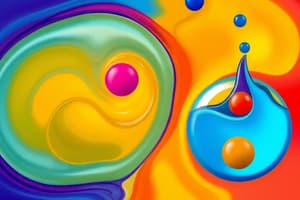Podcast
Questions and Answers
Which of the following correctly describes active transport?
Which of the following correctly describes active transport?
- Movement of molecules from low to high concentration using energy. (correct)
- Movement of molecules from high to low concentration without energy.
- Movement of water only, disregarding solute concentration.
- Movement of molecules in equilibrium across a membrane.
What is the main characteristic of hypotonic solutions?
What is the main characteristic of hypotonic solutions?
- They do not facilitate water movement across cell membranes.
- They have a higher concentration of solutes than blood.
- They have a lower concentration of solutes than blood. (correct)
- They cause cells to lose water and shrink.
Osmosis primarily involves the movement of which substance?
Osmosis primarily involves the movement of which substance?
- Active transport of electrolytes against a gradient.
- Buffers to maintain pH levels in cells.
- Solutes from low to high concentration.
- Water from a region of lower solute concentration to a higher solute concentration. (correct)
What effect does hypertonic IV solution have on cells?
What effect does hypertonic IV solution have on cells?
Which of the following is a common cause of fluid imbalance?
Which of the following is a common cause of fluid imbalance?
What role do electrolytes play in cellular hydration?
What role do electrolytes play in cellular hydration?
Which statement about diffusion is true?
Which statement about diffusion is true?
What happens to water molecules during osmosis when a cell is placed in a hypertonic solution?
What happens to water molecules during osmosis when a cell is placed in a hypertonic solution?
What is an example of active transport in humans?
What is an example of active transport in humans?
What characterizes dehydration?
What characterizes dehydration?
In which type of solution does endosmosis occur?
In which type of solution does endosmosis occur?
What happens to a cell in a hypertonic solution?
What happens to a cell in a hypertonic solution?
Which condition can lead to overhydration?
Which condition can lead to overhydration?
Osmotic pressure is primarily determined by which factor?
Osmotic pressure is primarily determined by which factor?
What is the process called when water moves out of the cell in a hypertonic solution?
What is the process called when water moves out of the cell in a hypertonic solution?
What is a common effect of dehydration on body fluids?
What is a common effect of dehydration on body fluids?
What role does intracellular fluid (ICF) primarily play in cellular functions?
What role does intracellular fluid (ICF) primarily play in cellular functions?
Which mechanism primarily maintains fluid output regulation in the body?
Which mechanism primarily maintains fluid output regulation in the body?
How does an increase in extracellular fluid (ECF) volume affect intracellular fluid (ICF)?
How does an increase in extracellular fluid (ECF) volume affect intracellular fluid (ICF)?
What is a key function of electrolytes in fluid balance?
What is a key function of electrolytes in fluid balance?
Which type of fluid does not cause net movement of water across a semipermeable membrane?
Which type of fluid does not cause net movement of water across a semipermeable membrane?
What happens to urine volume when antidiuretic hormone (ADH) levels increase?
What happens to urine volume when antidiuretic hormone (ADH) levels increase?
What effect does capillary blood pressure have on fluid balance?
What effect does capillary blood pressure have on fluid balance?
What can lead to dehydration of cells in the body?
What can lead to dehydration of cells in the body?
Flashcards are hidden until you start studying
Study Notes
Types of IV Solutions
- Isotonic Fluids maintain equal osmolarity with blood; example: 0.9% Normal Saline (0.9% NaCl).
- Hypotonic Fluids have lower solute concentration than blood, infusing cells with fluids; examples include 0.45% Saline, 0.25% Saline, and 5% Dextrose.
- Hypertonic Solutions contain higher concentrations of solutes; example: 3% Normal Saline (3% NaCl), causing cell water to move into the intravascular space.
Movements of Fluids
- Diffusion is the migration of molecules from high to low concentration, balancing concentration across membranes. Example: Copper sulfate in water eventually distributes evenly.
- Active Transport requires energy (ATP) to move molecules against a concentration gradient; vital for glucose uptake in the intestines and mineral uptake in plant roots.
- Osmosis is the movement of solvent molecules from low to high solute concentration through semi-permeable membranes. It is influenced by osmotic pressure, determined by solute concentration.
Types of Osmosis
- Endosmosis occurs in hypotonic solutions, where water moves into cells, causing them to swell (turgid).
- Exosmosis occurs in hypertonic solutions, where water exits the cell, causing it to shrink (flaccid).
Fluid Imbalances
- Dehydration results in reduced total body fluid volume when output exceeds intake, first affecting interstitial fluid then intracellular fluid (ICF) and plasma.
- Overhydration arises from excessive fluid intake compared to output, potentially caused by excessive IV fluids or rapid consumption of water, leading to water intoxication.
Body Fluid Compartments
- Intracellular Fluid (ICF) is the largest compartment, facilitating essential chemical reactions within cells.
Mechanisms Maintaining Fluid Balance
- Regulation of Fluid Output: Primarily managed through urine volume adjusted by Antidiuretic hormone (ADH), which enhances sodium and water reabsorption in the kidneys.
- Regulation of Fluid Intake: Extracellular fluid (ECF) electrolyte concentration affects ECF volume; enhanced ECF volume triggers ADH secretion.
- Fluid Exchange via Blood: Capillary blood pressure promotes water movement out of blood while blood protein concentration pulls water back into blood, regulating plasma and interstitial fluid balances.
Studying That Suits You
Use AI to generate personalized quizzes and flashcards to suit your learning preferences.




